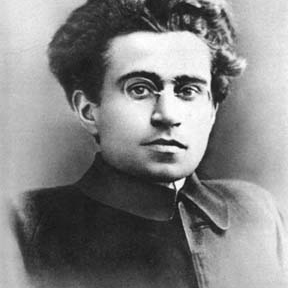
Antonio Gramsci
: Photo from Wikipedia / Author of Photo: Unknown authorOverview
* Italian Marxist and journalist
* Advocated the spread of Marxism by means of a “long march through the institutions” – i.e., gradual, incremental infiltration of such key institutions as the cinema and theater, the schools and universities, the seminaries and churches, the media, the courts, the labor unions, and at least one major political party
* Deceased in 1937
Antonio Gramsci was born in Sardinia on January 22, 1891. After graduating from the Dettori Lyceum in Sardinian capital of Cagliari, he won a scholarship to the University of Turin in 1911; by this point in his life, he was ideologically a socialist. Four years later he became an active member of the Italian Socialist Party (PSI) and began a journalistic career that saw him develop into one of Italy’s most influential writers. In the Turin edition of Avanti! (PSI’s official organ), Gramsci wrote a regular column on various aspects of the city’s social and political life. Also active in educating and organizing Turin’s workers, Gramsci in 1916 began speaking periodically at workers’ study-circles on such topics as the French and Italian revolutions and the writings of Karl Marx. When Russia’s Bolshevik revolution broke out in 1917, Gramsci embraced the goal of spreading socialist transformation throughout the capitalist world.
In the spring of 1919, Gramsci co-founded L’Ordine Nuovo: Rassegna Settimanale di Cultura Socialista (The New Order: A Weekly Review of Socialist Culture), which became an influential periodical among Italy’s radical and revolutionary Left. Meanwhile he continued to devote much of his time and energy to the development of the factory council movement, which sought to advance the cause of a proletarian revolution in Italy.
In January 1921 Gramsci aligned himself with the Communist minority within PSI at the Party’s Livorno Congress, and soon thereafter he became a central committee member of the Italian Communist Party (PCI).
From May 1922 to November 1923, Gramsci lived in Moscow as an Italian delegate to the Communist International. In 1924 he relocated to Rome and was named general secretary of PCI. He also began organizing the launch of PCI’s official newspaper, L’Unità (Unity).
In 1926, Italy’s Fascist government enacted a host of “Exceptional Laws for State Security,” designed to suppress political opposition. On November 8th of that year, Gramsci was arrested in Rome and was sentenced to 5 years in confinement on the island of Ustica. In June 1928, his prison sentence was increased to more than 20 years, including a stint in solitary confinement.
Gramsci’s health deteriorated badly during his incarceration, and in November 1933 he was transferred to a medical clinic in the Italian city of Formia, where he stayed, under constant police guard, until August 1935. At that point he was transferred again, still under perpetual guard, to the Quisisana Hospital in Rome. Gramsci eventually died there, of a cerebral hemorrhage, on April 27, 1937.
During his years as a prisoner, Gramsci filled 32 notebooks (containing almost 3,000 pages) with his political and philosophical meditations on how Marxist theory could be applied practically to the conditions of advanced capitalism. The notebooks, which were smuggled out from Gramsci’s prison cell, were eventually published in Italian several years after World War II, more than a decade after Gramsci’s death. They were not published in English, however, until the 1970s.
In his writings, Gramsci accepted Marx’s assertion that perpetual struggle between the ruling class and the subordinate working class was the driving mechanism that ultimately made social progress possible. But he rejected the notion that direct physical coercion by police and armies was the method of choice for achieving and maintaining victory in that struggle. Rather, Gramsci held that if a population at large could, for a period of time, be properly indoctrinated with a new “ideology”—specifically, a set of values, beliefs, and worldviews consistent with Marxist principles—a Marxist system could be sustained indefinitely and without coercion or force. In short, Gramsci held that Marxists needed to focus their efforts on gaining “hegemony” (i.e., control or dominion) over the core beliefs of non-Marxist societies; to change the population’s understanding of what constitutes basic “common sense.”
Such a development, said Gramsci, would never occur naturally as a result of some inexorable, unseen, “historical laws” that Marx had accepted as axiomatic. Rather, Gramsci called for Marxists to actively spread their ideology in a gradual, incremental, stealth manner, by infiltrating all existing societal institutions and embedding it, largely without being noticed, in the popular mind. This, he emphasized, was to be an evolutionary, rather than a revolutionary, process that, over a period of decades, would cause an ever-increasing number of people to embrace Marxist thought, until at last it achieved hegemony. (Rudi Dutschke, a prominent spokesperson of the German student movement of the 1960s, described this approach as a “long march through the institutions” — a phrase that is often mistakenly attributed to Gramsci). Among the key institutions that would need to be infiltrated were the cinema and theater, the schools and universities, the seminaries and churches, the media, the courts, the labor unions, and at least one major political party. According to Gramsci, these institutions constituted society’s “superstructure,” which, if captured and reshaped by Marxists, could lead the masses to abandon capitalism of their own volition, entirely without resistance or objection.
In this regard, Gramsci’s views bore a great resemblance to those of the famed godfather of community organizing, Saul Alinsky, who likewise viewed revolution as a slow, patient process requiring the stealth penetration of existing institutions that could then be transformed from within.
Additional Resources:
- How Obama Revolution Came to America
By Robert Chandler
April 6, 2009 - Gramscian Damage
By Eric Raymond
February 11, 2006Gramsci in His Own Words: - Antonio Gramsci’s Writings
By Marxists.org
Further Reading: “An Introduction to Gramsci’s Life and Thought” (Marxists.org); “Antonio Gramsci, Schooling and Education” (Infed.org); “Antonio Gramsci: Take Over the Institutions!” (American Thinker, 4-26-2014).